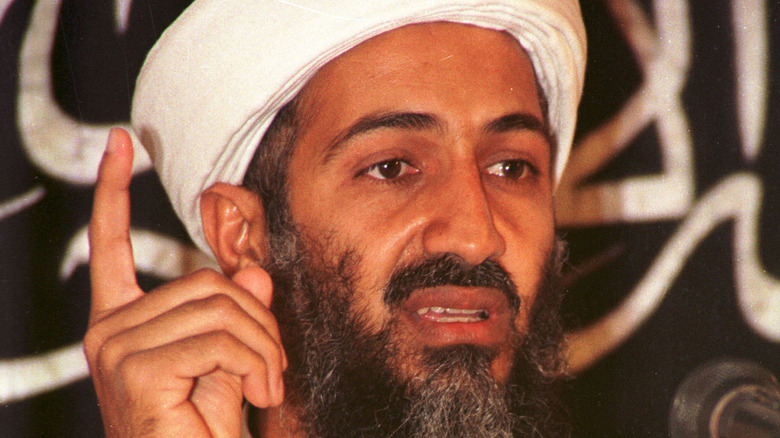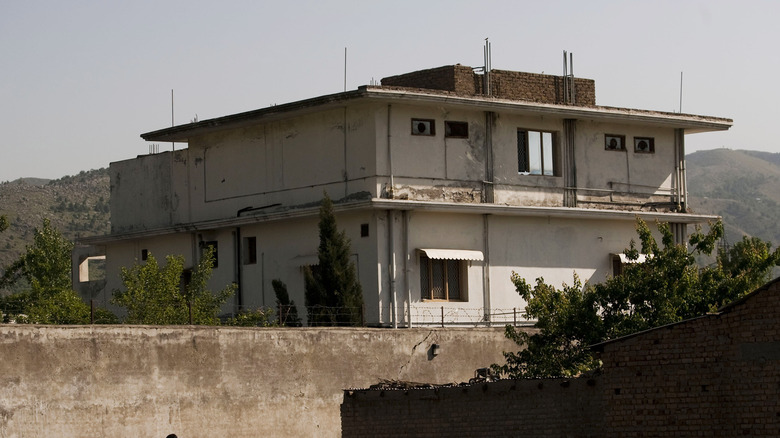The Unbelievable Story Of How The CIA Found Osama Bin Laden
The famous image of former President Barack Obama and then-Vice President Joe Biden sitting with several members of their cabinet and U.S. military officials in the Situation Room on May 1, 2011, is a picture that history will forever remember. It documented the reactions of top government officials watching the capture of Osama bin Laden (via History). What was happening on the other side of that image was the entire room watching live video footage of SEAL Team Six — a combat mission performing the covert military operation — carrying out their task to either capture or kill the mastermind behind the 9/11 terrorist attacks, says Military. It was a success.
Some hours after that photo was taken, Obama turned to Americans in a special televised late-night speech to announce the death of bin Laden on May 2, reported the Obama White House archives. The news was a victory for the U.S., which had finally caught and killed the wanted terrorist a decade after the devastating attacks. But later that day, many wondered how it was planned, and how did the U.S. military locate bin Laden almost 10 years after he became public enemy No. 1?
How the CIA located America's most wanted terrorist
While it was members of the special military group that performed the operation that killed Osama bin Laden, it was American intelligence officials who led them to his location.
The Saudi-born terrorist was killed in Pakistan in the early morning hours of May 2, 2011. After being on the run for so long, it was believed that bin Laden was hiding in some undisclosed area. In actuality, he was brazenly living in the Pakistani city of Abbottabad for the last five years of his life, per History. The Central Intelligence Agency (CIA) had learned this the year before when they tracked a member of bin Laden's radical terrorist group — al-Qaida — visiting a large and guarded structure. In the days after closely watching the associate at the location, they presumed that this large compound, which stood out compared to other residences, was a destination of importance, per Military.
The compound that bin Laden was living in was three floors. Each floor had several rooms, and in total, the house had nine bedrooms, eight bathrooms, and two kitchens (via History). The third floor is where bin Laden lived and spent the majority of his time, restricting himself to just two rooms, per The Guardian.
With continued monitoring of the house, the CIA determined that members of bin Laden's family were living there. The home's occupants were bin Laden, several of his wives, children, and grandchildren, as well as his bodyguards and their wives and children. CIA director Leon Panetta would later say that the agency had to believe all of their initial assumptions about bin Laden's possible whereabouts were wrong before moving forward with the lead that he was actually in Abbottabad (via Harvard Business Review).
The bin Laden intel that almost wasn't
Despite not having concrete proof that bin Laden himself was at the location, President Obama was confident in the hunch and approved the mission to capture or kill. In late April 2011, after eight months of secretly organizing, SEAL Team Six had the authorization, and the mission was officially active when the team took off from a U.S. military base in Afghanistan en route to Abbottabad (via Biography). In a few hours, Osama bin Laden, America's most wanted terrorist, was dead.
Including bin Laden, the total number of casualties were five people — four men and one woman (via CNN). Two other women were wounded. One of his sons, Khalid bin Laden, was killed. The other men killed were bodyguards for the terrorist leader. In the aftermath of the raid, American and Pakistani officials questioned three wives and about six children of the slain al-Qaida leader (via ABC News).
While earlier intel couldn't completely say for certain that the tall bearded man they killed on the third floor of the compound was actually bin Laden, a DNA test would confirm it was. A statement from al-Qaida that their leader was dead was another confirmation (via BBC).
In 2012, the Pakistani government began demolition of the bin Laden compound (pictured), according to Reuters. Today, the site is just empty land where animals roam free, per the New York Post. Books discussing the timeline of the mission to kill bin Laden include journalist Peter Bergen's book "Manhunt: The Ten Year Search for Bin Laden From 9/11 to Abbottabad" as well as Panetta's book "Worthy Fights: A Memoir of Leadership in War and Peace."


